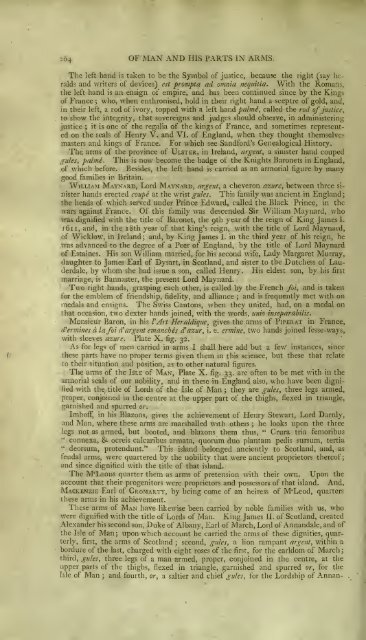A System of Heraldry - Clan Strachan Society
A System of Heraldry - Clan Strachan Society
A System of Heraldry - Clan Strachan Society
Create successful ePaper yourself
Turn your PDF publications into a flip-book with our unique Google optimized e-Paper software.
26 4<br />
OF MAN AND HIS PARTS IN ARMS.<br />
The left hand is taken to be the Symbol <strong>of</strong> justice, because the right (say he<br />
raids and writers <strong>of</strong> devices) est prompta ad omnia nequitia. With the Romans,<br />
the left hand is an ensign <strong>of</strong> empire, and has been continued since by the Kings<br />
<strong>of</strong> France ;<br />
who, when enthronised, hold in their right hand a sceptre <strong>of</strong> gold, and,<br />
in their left, a rod <strong>of</strong> ivory, topped with a left hand palms', called the rod <strong>of</strong> justice,<br />
to show the integrity, that sovereigns and judges should observe, in administering<br />
justice ; it is one <strong>of</strong> the regalia <strong>of</strong> the kings <strong>of</strong> France, and sometimes represent<br />
ed on the seals <strong>of</strong> Henry V. and VI. <strong>of</strong> England, when they thought themselves<br />
masters and kings <strong>of</strong> France. For which see Sandford's Genealogical History.<br />
The arms <strong>of</strong> the province <strong>of</strong> ULSTER, in Ireland, argent, a sinister hand couped<br />
gules, palme. This is now become the badge <strong>of</strong> the Knights Baronets in England,<br />
<strong>of</strong> which before. Besides, the left hand is carried as an armorial figure by many<br />
good families in Britain.<br />
WILLIAM MAYNARD, Lord MAYNARD, argent, a cheveron azure, between three sinister<br />
hands erected coupe at the wrist gules. This family was ancient in England;<br />
the heads <strong>of</strong> which served under Prince Edward, called the Black Prince, in the<br />
wars against France. Of this family was descended Sir William Maynard, who<br />
was dignified with the title <strong>of</strong> Baronet, the 9th year <strong>of</strong> the reign <strong>of</strong> King I. James<br />
1611, and, in the i8th year <strong>of</strong> that king's reign, with the title <strong>of</strong> Lord Maynard,<br />
<strong>of</strong> Wicklow, in Ireland; and, by King James I. in the third year <strong>of</strong> his reign, he<br />
was advanced to the degree <strong>of</strong> a Peer <strong>of</strong> England, by the title <strong>of</strong> Lord Maynard<br />
<strong>of</strong> Estaines. His son William married, for his second wife, Lady Margaret Murray,<br />
daughter to James Earl <strong>of</strong> Dysart, in Scotland, and sister to the Dutchess <strong>of</strong> Lauderdale,<br />
by whom she had issue a son, called Henry. His eldest son, by his first<br />
marriage, is Bannaster, the present Lord Maynard.<br />
Two right hands, grasping each other, is called by the French foi, and is taken<br />
for the emblem <strong>of</strong> friendship, fidelity, and alliance ; and is frequently met with on<br />
medals and ensigns. The Swiss Cantons, when they united, had, on a medal on<br />
that occasion, two dexter hands joined, with the words, unio inseparabilis.<br />
Monsieur Baron, in his TArt Heraldique, gives the arms <strong>of</strong> PIPERAT in France,<br />
d''ermines a la d1<br />
foi argent emanches d'azur, i. e. ermine, two hands joined fesse-ways,<br />
with sleeves azure. Plate X. fig. 32.<br />
As for legs <strong>of</strong> men carried in arms I shall here add but a few" instances, since<br />
these parts have no proper terms given them in this science, but these that relate<br />
to their situation and position, as to other natural figures.<br />
The arms <strong>of</strong> the ISLE <strong>of</strong> MAN, Plate X. fig. 33. are <strong>of</strong>ten to be met with in the<br />
armorial seals <strong>of</strong> our nobility, and in these in England also, who have been dignified<br />
with the title <strong>of</strong> Lords <strong>of</strong> the Isle <strong>of</strong> Man ; they are gules, three legs armed,<br />
proper, conjoined in the centre at the upper part <strong>of</strong> the thighs, flexed in triangle,<br />
garnished and spurred or.<br />
Imh<strong>of</strong>f, in his Blazons, gives the achievement <strong>of</strong> Henry Stewart, Lord Darnly,<br />
and Man, where these arms are marshalled with others ; he looks upon the three<br />
legs not as armed, but booted, and blazons them thus, " Crura tria femoribus<br />
'<br />
'<br />
connexa, &- ocreis calcaribus armata, quorum duo plantam pedis sursum, tertia<br />
deorsum, protendunt." This island belonged anciently to Scotland, and, as<br />
feudal arms, were quartered by the nobility that were ancient proprietors there<strong>of</strong>;<br />
and since dignified with the title <strong>of</strong> that island.<br />
The M'LEODS quarter them as arms <strong>of</strong> pretension with their own. Upon the<br />
account that their progenitors were proprietors and possessors <strong>of</strong> that island. And,<br />
MACKENZIE Earl <strong>of</strong> CROMARTY, by being come <strong>of</strong> an heiress <strong>of</strong> M'Leod, quarters<br />
these arms in his achievement.<br />
These arms <strong>of</strong> MAN have likewise been carried by no"ble families with us, who<br />
were dignified with the title <strong>of</strong> Lords <strong>of</strong> Man. King James II. <strong>of</strong> Scotland, created<br />
Alexander his second son, Duke <strong>of</strong> Albany, Earl <strong>of</strong> March, Lord <strong>of</strong> Annandale, and <strong>of</strong><br />
the Isle <strong>of</strong> Man; upon which account he carried the arms <strong>of</strong> these dignities, quarterly,<br />
first, the arms <strong>of</strong> Scotland ; second, gules, a lion rampant argent, within a<br />
bordure <strong>of</strong> the last, charged with eight roses <strong>of</strong> the first, for the earldom <strong>of</strong> March;<br />
third, gules, three legs <strong>of</strong> a man armed, proper, conjoined in the centre, at the<br />
upper parts <strong>of</strong> the thighs, flexed in triangle, garnished and spurred or, for the<br />
Isle ot Man ; and fourth, or, a saltier and chief gules, for the Lordship <strong>of</strong> Annan-




